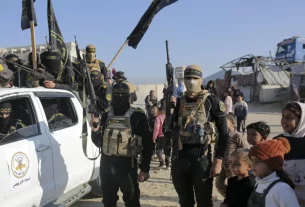Global inflation has been one of the big economic stories of 2022 and as any household with debt knows, this has triggered a tsunami of interest rate hikes around the world to contain price pressures. This has also contributed to an emerging humanitarian crisis, notably in but not confined to Africa, at a time when a slowing global economy and rising food import bills limit the capacity to alleviate the tragedy.
And it is a tragedy on a terrifying and heart-breaking scale.
“Across Africa, from east to west, people are experiencing a food crisis that is bigger and more complex than the continent has ever seen, say diplomats and humanitarian workers. One in five Africans – a record 278 million people – were already facing hunger in 2021, according to data from the UN Food and Agriculture Organization. It says the situation has worsened,” a recent Reuters report said.
The number of east Africans experiencing acute food insecurity – when a lack of food puts lives or livelihoods in immediate danger – has spiked by 60% in just the past year, and by nearly 40% in west Africa, according to the World Food Programme.
A look at the map of Africa on the Famine Early Warning Systems Network (Fews Net) shows swathes of the Horn of Africa and east Africa coloured in red, which signals an emergency situation that is one shade below the dark hue that signals famine.
“Famine is projected to emerge in three areas in southern Somalia in April to June 2023 if current high levels of multisectoral humanitarian assistance are not sustained,” Fews Net said recently.
Visit Daily Maverick’s home page for more news, analysis and investigations
In southern Africa, huge parts of Mozambique and Zimbabwe are stamped with orange, denoting a “crisis”. Much of the continent is marked yellow, signifying stress. South Africa is currently excluded from any food insecurity marking, but all Daily Maverick readers will be aware that hunger stalks this land. People don’t beg at robots for the fun of it.
In April, my colleague Estelle Ellis reported that 14 children below the age of five had starved to death in Nelson Mandela Bay over the previous 15 months, while 216 new cases of severe acute malnutrition had been confirmed in the Eastern Cape’s biggest metro over that period.
Read more in Daily Maverick: “Are children dying of hunger and malnutrition viewed as less ‘deserving’ of help?”
This was stinging testimony to the failure of the local government in the province to do the basics of its job on the “social development” front.
In November, my colleague Felix Dlangamandla and I visited a rural school in the former Transkei where the teachers said the children would have to be released to go home for the day at noon because the daily meal they are supposed to receive from the Department of Education had not been provided. Hunger awaited many at home.
Read more in Daily Maverick: “How the twilight of SA’s migrant labour system spawned a social apocalypse”
And South African food inflation continues to pick up at a worrying pace. Consumer food inflation in the year to November accelerated to 12.8% from 12.3% in the previous month, a trend that will continue to exact a toll on poor and working-class households who are bearing the brunt of the “cost-of-living crisis”.
On a global level, the International Monetary Fund (IMF) recently warned that food prices are expected to remain elevated because of Russia’s invasion of Ukraine, energy costs and the La Niña weather pattern.
“La Niña weather conditions are forecast to return for a third straight year, bringing below-average water temperatures to the east-central Pacific Ocean, according to the UN’s World Meteorological Organization. Similar three-year periods occurred during the first world food crisis between 1973 and 1976 and again between 1998 and 2001,” the Washington-based lender said.
La Niña has brought much rainfall over large parts of southern Africa but has spawned catastrophic drought in east Africa, and its intensity has been linked to climate change.
Meanwhile, Vladimir Putin’s invasion of Ukraine continues to fuel global food prices, not least because both countries are major grain producers. It is a searing indictment of Putin’s ANC apologists that they have not made the connection between surging hunger in Africa and Putin’s war.
“Food prices, which reached a record earlier this year, have increased food insecurity and raised social tensions. They have also strained the budgets of governments struggling with rising food import bills and diminished capacity to fund extra social protection for the most vulnerable,” the IMF says.
It’s been almost 40 years since Bob Geldof and Midge Ure’s Do They Know It’s Christmas hit the airwaves to raise money for victims of a famine in Ethiopia. That song admittedly had its miscues: Ethiopia was Christian centuries before the cross came to Geldof’s Ireland. But you can’t really fault the intentions.
I don’t mean to spoil anyone’s Christmas braai. This is the time of the year to eat, drink and be merry. But perhaps we can all spare a thought or some loose change as this Christmas the entire continent is in the grip of an unfolding hunger crisis that is even worse than the 1980s catastrophe. And climate change and Vladimir Putin are among the biggest culprits. DM/BM
![]()



